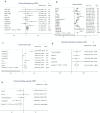Aberrations of biochemical indicators in amyotrophic lateral sclerosis: a systematic review and meta-analysis
- PMID: 33419478
- PMCID: PMC7792103
- DOI: 10.1186/s40035-020-00228-9
Aberrations of biochemical indicators in amyotrophic lateral sclerosis: a systematic review and meta-analysis
Abstract
Accumulating evidence has suggested that the pathological changes in amyotrophic lateral sclerosis (ALS) are not only confined to the central nervous system but also occur in the peripheral circulating system. Here, we performed a meta-analysis based on the PubMed, EMBASE, EBSCO, and CNKI databases, to find out biochemical indicators associated with energy metabolism, iron homeostasis, and muscle injury that are altered in ALS patients and their correlations with ALS phenotypes. Forty-six studies covering 17 biochemical indicators, representing 5454 ALS patients and 7986 control subjects, were included in this meta-analysis. Four indicators, including fasting blood glucose level (weighted mean difference [WMD] = 0.13, 95% CI [0.06-0.21], p = 0.001), serum ferritin level (WMD = 63.42, 95% CI [48.12-78.73], p < 0.001), transferrin saturation coefficient level (WMD = 2.79, 95% CI [1.52-4.05], p < 0.001), and creatine kinase level (WMD = 80.29, 95% CI [32.90-127.67], p < 0.001), were significantly higher in the ALS patients, whereas the total iron-binding capacity (WMD = - 2.42, 95% CI [- 3.93, - 0.90], p = 0.002) was significantly lower in ALS patients than in the control subjects. In contrast, the other 12 candidates did not show significant differences between ALS patients and controls. Moreover, pooled hazard ratios (HR) showed significantly reduced survival (HR = 1.38, 95% CI [1.02-1.88], p = 0.039) of ALS patients with elevated serum ferritin levels. These findings suggest that abnormalities in energy metabolism and disruption of iron homeostasis are involved in the pathogenesis of ALS. In addition, the serum ferritin level is negatively associated with the overall survival of ALS patients.
Keywords: Amyotrophic lateral sclerosis; Biochemical indicators; Creatinine kinase; Energy homeostasis; Iron metabolism.
Conflict of interest statement
The authors declare that they have no competing interests.
Figures





Similar articles
-
Abnormal Serum Iron-Status Indicator Changes in Amyotrophic Lateral Sclerosis (ALS) Patients: A Meta-Analysis.Front Neurol. 2020 May 20;11:380. doi: 10.3389/fneur.2020.00380. eCollection 2020. Front Neurol. 2020. PMID: 32508736 Free PMC article.
-
Increased serum ferritin levels in amyotrophic lateral sclerosis (ALS) patients.J Neurol. 2008 Nov;255(11):1652-6. doi: 10.1007/s00415-008-0945-0. Epub 2008 Jul 18. J Neurol. 2008. PMID: 18677636
-
Elevated serum ferritin is associated with reduced survival in amyotrophic lateral sclerosis.PLoS One. 2012;7(9):e45034. doi: 10.1371/journal.pone.0045034. Epub 2012 Sep 14. PLoS One. 2012. PMID: 23024788 Free PMC article.
-
Meta-analysis of the relationship between amyotrophic lateral sclerosis and susceptibility to serum ferritin level elevation.Neurosciences (Riyadh). 2016 Apr;21(2):120-5. doi: 10.17712/nsj.2016.2.20150482. Neurosciences (Riyadh). 2016. PMID: 27094521 Free PMC article.
-
Routine blood biochemical biomarkers in amyotrophic lateral sclerosis: Systematic review and cohort analysis.Amyotroph Lateral Scler Frontotemporal Degener. 2025 May;26(3-4):303-321. doi: 10.1080/21678421.2024.2435976. Epub 2024 Dec 5. Amyotroph Lateral Scler Frontotemporal Degener. 2025. PMID: 39636698
Cited by
-
Muscle Function Differences between Patients with Bulbar and Spinal Onset Amyotrophic Lateral Sclerosis. Does It Depend on Peripheral Glucose?J Clin Med. 2021 Apr 9;10(8):1582. doi: 10.3390/jcm10081582. J Clin Med. 2021. PMID: 33918552 Free PMC article.
-
Analysis of routine blood parameters in patients with amyotrophic lateral sclerosis and evaluation of a possible correlation with disease progression-a multicenter study.Front Neurol. 2022 Jul 27;13:940375. doi: 10.3389/fneur.2022.940375. eCollection 2022. Front Neurol. 2022. PMID: 35968316 Free PMC article.
-
Decremental response in patients with amyotrophic lateral sclerosis during repetitive nerve stimulation and its relationships with impaired homeostasis.Front Aging Neurosci. 2025 Jan 7;16:1502025. doi: 10.3389/fnagi.2024.1502025. eCollection 2024. Front Aging Neurosci. 2025. PMID: 39839311 Free PMC article.
-
The updated development of blood-based biomarkers for Huntington's disease.J Neurol. 2023 May;270(5):2483-2503. doi: 10.1007/s00415-023-11572-x. Epub 2023 Jan 24. J Neurol. 2023. PMID: 36692635 Free PMC article. Review.
-
Mitochondrial Aconitase and Its Contribution to the Pathogenesis of Neurodegenerative Diseases.Int J Mol Sci. 2024 Sep 15;25(18):9950. doi: 10.3390/ijms25189950. Int J Mol Sci. 2024. PMID: 39337438 Free PMC article. Review.
References
Publication types
MeSH terms
Substances
Grants and funding
LinkOut - more resources
Full Text Sources
Other Literature Sources
Medical
Miscellaneous

